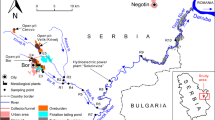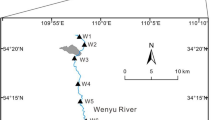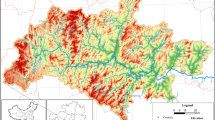Abstract
Epikarst water, which is one of the most important water resources in karst mountain areas, is extremely sensitive to mining activities. Acid mine drainage (AMD) with high levels of heavy metals can degrade the water quality. A typical coalfield basin was chosen to research the migration process of heavy metals. It was found that the chemical compositions of the stream water in the research field were controlled by the dissolution of carbonate rocks or/and the weathering and oxidation of pyrite in the mining area. Excluding a few sites in the mining area, As(V) was dominant species of arsenic in the form of H2AsO4 − or HAsO4 2− in the research field. Based on the mass balance concept, it was found that fluxes of As, Zn, Cu and Cd in water from the mining area (site 17) affected by AMD were 18, 871, 281 and 12 kg year−1, respectively. Also, concentrations of Cd, Zn, As and Cu in the stream water decreased along the flow, because these ions deposited from the water to the stream bed as the redistribution processes in environment.







Similar content being viewed by others
References
Acero P, Ayora C, Torrentó C, Nieto JM (2006) The behavior of trace elements during schwertmannite precipitation and subsequent transformation into goethite and jarosite. Geochim Cosmochim Acta 70:4130–4139
An D, Li DS (2005) Epidemiological status and countermeasures of endemic arseniasis of Guizhou Province. Chin J Endemiol 24:214–216
Arambarri P, Cabrera F, González-Quesada R (1996) Quality evaluation of the surface waters entering the Doñana National Park (SW Spain). Sci Total Environ 191:185–196
Bakalowicz M (2004) The epikarst, the skin of karst. In: Jones WK, Culver DC, Herman JS (eds) Epikarst. Proceedings of the symposium held 1–4 October 2003, Shepherdstown, WV. Karst Waters Institute, Charles Town, pp 16–22
Balci N, Shanks III, Wayne C, Mayer B, Mandernack Kevin W (2007) Oxygen and sulfur isotope systematics of sulfate produced by bacterial and abiotic oxidation of pyrite. Geochim Cosmochim Acta 71:3796–3811
Bigham JM, Schwertmann U, Carlson L, Murad E (1990) A poorly crystallized oxyhydroxysulfate of iron formed by bacterial oxidation of Fe(II) in acid mine waters. Geochim Cosmochim Acta 54:2743–2758
Casiot C, Morin G, Juillot F, Bruneel O, Personné JC, Leblanc M, Duquesne K, Bonnefoy V, Elbaz-Poulichet F (2003) Bacterial immobilization and oxidation of arsenic in acid mine drainage (Carnoulès creek France). Water Res 37:2929–2936
Casiot C, Egal M, Elbaz-Poulichet F, Bruneel O, Bancon-Montigny C, Marie-Ange C, Gomez E, Aliaume C (2009) Hydrological and geochemical control of metals and arsenic in a Mediterranean river contaminated by acid mine drainage (the Amous River, France); preliminary assessment of impacts on fish (Leuciscus cephalus). Appl Geochem 24:787–799
Chen CJ, Chen CW, Wu MM, Kuo TL (1992) Cancer potential in liver, lung, bladder, and kidney due to ingested inorganic arsenic in drinking water. Br J Cancer 66:888–892
Cheng HF, Hu YN, Luo J, Xu B, Zhao JF (2009) Geochemical processes controlling fate and transport of arsenic in acid mine drainage (AMD) and natural systems. J Hazard Mater 165:13–26
Davis JC (1986) Statistics and data analysis in geology. Wiley, Singapore, p 646
Ding ZH, Zheng BS, Finkelman RB, Belkin HE, Chen CG, Zhou DX, Zhou YS (2000) Distribution of high arsenic coals from Southwest Guizhou Province. Geochimica 29:493–494
Grande JA, Jiménez A, Romero S, de la Torre ML, Gómez-Olivera T (2010) Quantification of heavy metals from AMD discharged into a public water supply dam in the Iberian Pyrite Belt (SW Spain) using centered moving average. Water Air Soil Pollut 212:299–307
Hudson-Edwards KA, Maclin MG, Jamieson HE, Brever PA, Coulthard TJ, Howard AJ, Turner JN (2003) The impact of tailings dam spills and clean-up operations on sediment and water quality in river systems; the Ríos Agrio-Guadiamar, Aznalcóllar, Spain. Appl Geochem 18:221–239
Johnson DB, Hallberg KB (2005) Acid mine drainage remediation options: a review. Sci Total Environ 338:3–14
Li M (2007) Environmental impact assessment of As(arsenic)during the exploitation and utilization of high-As coal. J Meteorol Environ 23:67–71
Lin C, Wu Y, Lu W, Chen A, Liu Y (2007) Water chemistry and ecotoxicity of an acid mine drainage-affected stream in subtropical China during a major flood event. J Hazard Mater 142:199–207
Lu YR (2007) Karst water resources and geoecology in typical regions of China. Environ Geol 51:695–699
Moral F, Cruz-Sanjulián JJ, Olías M (2008) Geochemical evolution of groundwater in the carbonate aquifers of Sierra de Segura (Betic Cordillera, southern Spain). J Hydrol 360:281–296
Nebel BJ, Wright RT (1999) Ciencias ambientales. Ecologíay desarrollo sostenible. Prentice, México
Olías M, Cerón JC, Moral F, Ruiz F (2006) Water quality of the Guadiamar River after the Aznalcóllar spill (SW Spain). Chemosphere 62:213–225
Plumlee GS, Smith KS, Montour MR, Ficklin WH, Mosier EL (1999) Geologic controls on the composition of natural waters and mine waters draining diverse mineral-deposit types. In: Filipek LH, Plumlee GS (eds) The environmental geochemistry of mineral deposits, part B: case studies and research topics, vol 6B. Rev Econ Geol, pp 373–432
Sáinz A, Grande JA, de la Torre ML, Sánchez-Rodas D (2002) Characterization of sequential leachate discharges of mining waste rock dumps in the Tinto and Odiel rivers. J of Environ Manag 64:345–353
Saria L, Shimaoka T, Miyawaki K (2006) Leaching of heavy metals in acid mine drainage. Waste Manag Res 24:134–140
Satapathy DR, Salve PR, Katpatal YB (2009) Spatial distribution of metals in ground/surface waters in the Chandrapur district (Central India) and their plausible sources. Environ Geol 56:1323–1352
Sheoran AS, Sheoran V (2006) Heavy metal removal mechanism of acid mine drainage in wetlands: a critical review. Miner Eng 19:105–116
Smedley PL, Kinniburgh DG (2002) A review of the source, behavior and distribution of arsenic in natural waters. Appl Geochem 17:517–568
Stanić T, Daković A, Zivanović A, Tomaševišć-Čanović M, Dondur V, Milićević S (2009) Adsorption of arsenic (V) by iron (III)-modified natural zeolitic tuff. Environ Chem Lett 7:161–166
Strosnider WHJ, Llanos López FS, Nairn RW (2011a) Acid mine drainage at Cerro Rico de Potosí I: unabated high-strength discharges reflect a five century legacy of mining. Environ Earth Sci 64:899–910
Strosnider WHJ, Llanos López FS, Nairn RW (2011b) Acid mine drainage at Cerro Rico de Potosí II: severe degradation of the Upper Rio Pilcomayo watershed. Environ Earth Sci 64:911–923
Stumm W, Morgan JJ (1996) Aquatic chemistry. Wiley, New York
Sun J, Wu P, Han ZW, Zhang CP, Liu H (2009) Influence of wastewater from a high arsenic coal mine on quality of epikarst water. Res Environ Sci 22:1440–1444
Tang CY, Wu P, Tao XZ, Zhang CP, Han ZW (2009) The basin acidification affected by AMD: a case study in Xingren County, Guizhou, China. Carsologica Sin 28:135–143
Williams M (2001) Arsenic in mine waters: an international study. Environ Geol 40:267–278
Wu P, Tang CY, Liu CQ, Zhu LJ, Pei TQ, Feng LJ (2009a) Geochemical distribution and removal of As, Fe, Mn and Al in a surface water system affected by acid mine drainage at a coalfield in Southwestern China. Environ Geol 57:1457–1467
Wu P, Tao XZ, Yang Y (2009b) Arsenic species in stream sediment at a high arsenic coal. Bull Mineral Petrol Geochem 28(Suppl):403
Yu JY, Heo B, Choi IK, Cho JP, Chang HW (1999) Apparent solubilities of schwertmannite and ferrihydrite in natural stream waters polluted by mine drainage. Geochim Cosmochim Acta 63:3407–3416
Zhou DX, Liu DN, Zhu SL, Zhou CL (1993) Investigation of chronic arsenic poisoning caused by high arsenic coal pollution. Chin J Prev Med 27:147–150
Acknowledgments
The authors are grateful to the reviewers. Also the authors wish to thank Dr. Zining Cui and Jessica Chan for their helpful comments and criticisms of English writing. It should be mentioned that this work is funded by the National Natural Science Foundation of China (No. 40963005), Key Discipline Construction Project of Guizhou University (No. Karst 200902) and the Science and Technology Project of Guizhou Province (No. SY [2009] 3059).
Author information
Authors and Affiliations
Corresponding author
Rights and permissions
About this article
Cite this article
Sun, J., Tang, C., Wu, P. et al. Migration of Cu, Zn, Cd and As in epikarst water affected by acid mine drainage at a coalfield basin, Xingren, Southwest China. Environ Earth Sci 69, 2623–2632 (2013). https://doi.org/10.1007/s12665-012-2083-3
Received:
Accepted:
Published:
Issue Date:
DOI: https://doi.org/10.1007/s12665-012-2083-3




